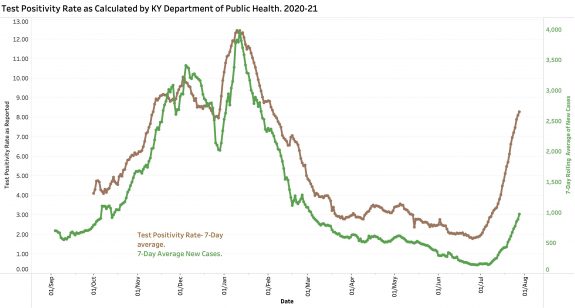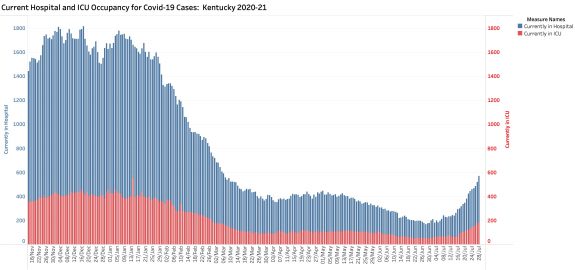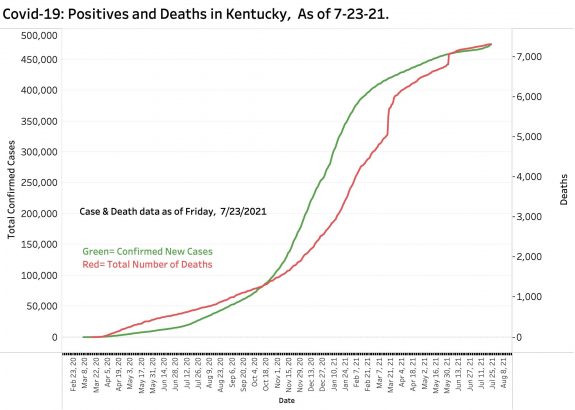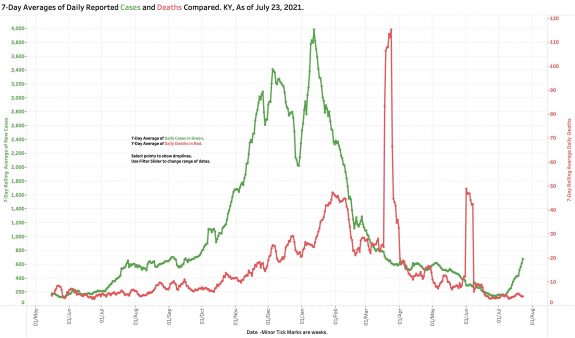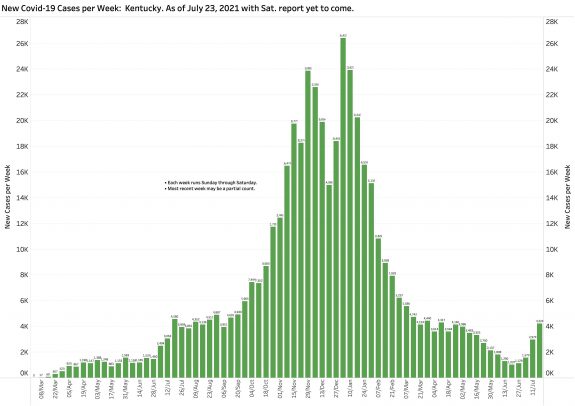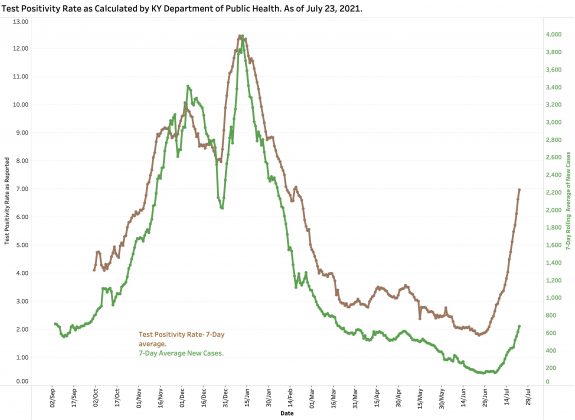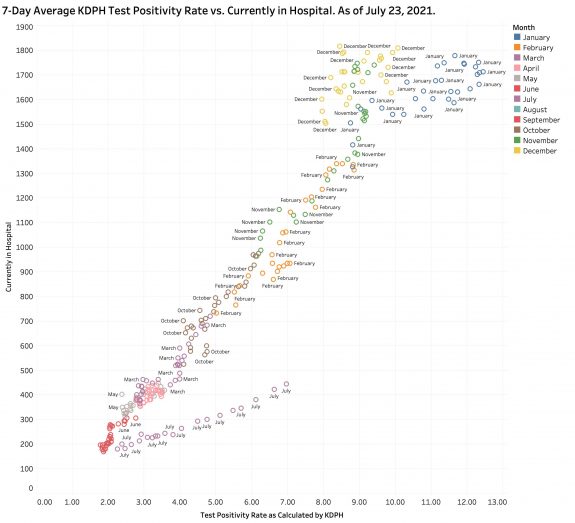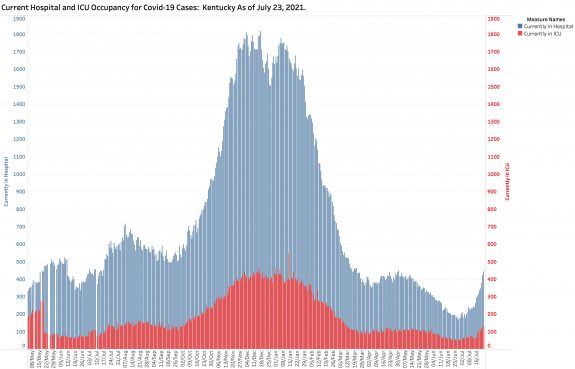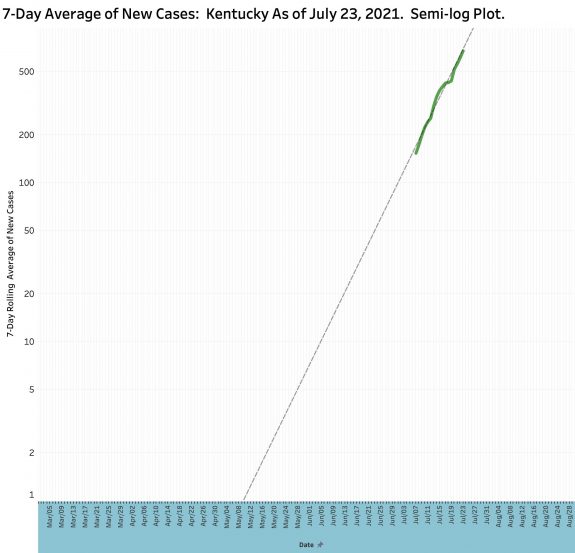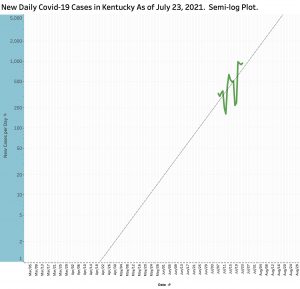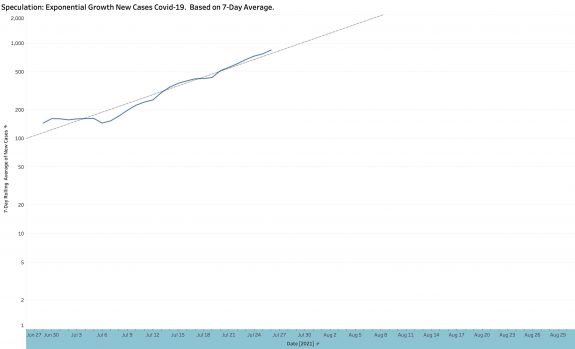It is starting all over again!
Kentucky’s Covid-19 statistics were updated last Monday evening closing out the weekend days of Saturday and Sunday. All three of those days had the highest numbers of new cases reported for their weekday since the waning of the winter’s epidemic in early February, 2021. The numbers reported on Monday were dwarfed by Tuesday evening’s report of 1,803 new cases and today’s of 2,583. Current hospital and ICU utilization are similarly rocketing upwards with totals and at rates matching those of last November’s prelude to December’s epidemic disaster. Current numbers, including the Test Positivity Rate are also increasing in an exponential manner with doubling times measured in days, not weeks. Today’s Test Positivity Rate of 10.08 is headed for January’s high of 12.45. The 7-day average of new cases exceeds the 14-day average by the largest measure since January also indicating rapid epidemic expansion. Deaths are beginning to creep up with 10 this evening. It is not an exaggeration to use terms such as “on fire,” or “explosion” to describe the current state of Kentucky’s Covid-19 epidemic.
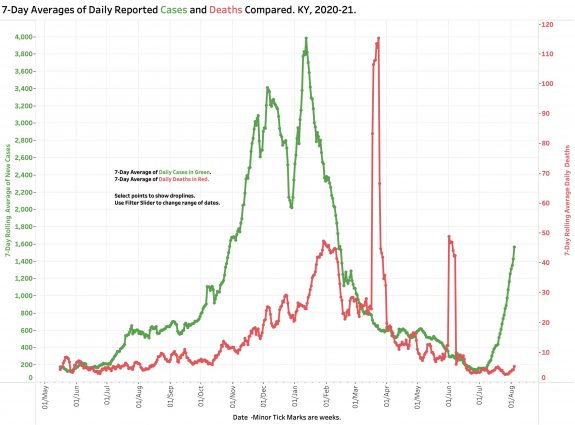
Our state does not make historic county data available in a usable digital form to the public, but I must assume some of our counties are feeling a greater impact of expansion than the Commonhealth as a whole. It gives me little comfort to consider that some “hands off” states like Florida or Texas are in a much worse position. We know what is happening to us. The issue is what are we going to do about it as individuals and as a community? Let nature take its course? We can do better. I argue that we already know what works to mitigate the immediate and long-term damage of Covid-19 but lack the commitment to each other to stand united.
The reader is invited to review KHPI’s portfolio of data visualizations on its Tableau Public website.
How about that Delta virus?
Much is being written about how the CDC, other government entities, and business organizations are handling issues related to masking and other non-medicinal public health measures to combat the Coronavirus. Some private entities now require immunization for employment or access. Although it should not have been necessary as nationwide case data was speaking for itself, an analysis of a July Covid-19 super-spreader event in Barnstable County, Massachusetts put the issues right on the table. A preliminary report by the CDC in their regular publication “Morbidity and Mortality Weekly Report” (MMWR) was made available to the public on July 30. This and a slide deck of related internal CDC discussion are available to anyone. Let me know if these links do not work for you.
Summary of the CDC report of July 30, 2021.
Barnstable County includes all of Cape Cod which is famous for its Fourth of July parties and other celebratory activities that draw participants from all over. During the month of July, 469 cases of Covid-19 associated with multiple summer events were identified among Massachusetts residents. Of those discovered to be infected, 74% were symptomatic. These infected persons reported attending densely packed indoor and outdoor events that included bars, restaurants, guest houses and rental homes. An initial outreach from the Massachusetts Department of Public Health revealed secondary transmission to at least 22 other states– so far! This outbreak epitomizes the definition of a super-spreader event that was largely focused in a single party-town.
Other observations from this outbreak have considerable relevance for the rest of us. Of the 133 patients in whom the analysis was performed, 89% were due to the Delta variant. Some 74% of cases occurred in fully vaccinated individuals! Of the 274 vaccinated patients with these “breakthrough infections,” some 79% were symptomatic with the rest presumably asymptomatic carriers. The viral RNA test used to diagnose Covid-19 disease or identify viral carriage can provide a measure of the amount of virus in the nasal cavity. It was demonstrated that there was no significant difference in the amount of viral RNA in the noses of those who were vaccinated or not. There were only 5 known Covid-19 patients who were known to have been hospitalized of which 4 were fully vaccinated. There were no deaths reported at the time of the report on July 30, 2021.
The CDC analysis describes a unique outbreak whose specific numbers, percentages, or rates cannot be generalized nationally but which are relevant based on solid epidemiologic and medical principles. For one thing, only Massachusetts residents were included in the analysis– out-of-staters were ignored. There was a detection bias such that symptomatic patients were much more likely to be included in the analysis. The demographics of the patients were not representative of the nation as a whole. They were much more likely to be male (85%), younger with a median age of 40, and likely whiter and better off financially in upscale vacation-destination Cape Cod. My guess is that few of the infected wore masks. Nothing has been reported about preexisting health conditions in the patients except that of the 5 known hospitalized patients, the single unvaccinated patient and 2 of the fully vaccinated ones had underlying medical conditions.
To what extent does vaccination decrease person to person spread?
In addition to the evidence of high transmissibility of the Delta variant, the frequency of apparent breakthrough infections in this specific population and the high viral-RNA lodes in vaccinated individuals raises the issue of whether vaccinated viral carriers, symptomatic or not, are capable of passing the virus to others. I am unaware of specific information to settle this important issue, but it seems to me to be operationally reasonable to assume that some degree of transmissibility from the vaccinated is possible until disproved by a more structured analysis able to answer the question. Breakthrough infections are still considered infrequent in the general public– so far!
The observations from the Barnstable outbreak are relevant to and reinforce our understanding of the current state of our national epidemic. What can happen in Cape Cod has the potential to happen anywhere else albeit to greater or lesser degree. We ignore the lessons at our peril. I can only repeat the recommendations stated in the MMWR report that themselves are rather modest.
Recommendations from the MMWR Report.
“Event organizers and local health jurisdictions should continually assess the need for additional measures, including limiting capacity at gatherings or event postponement, based on current rates of COVID-19 transmission, population vaccination coverage, and other factors.”
“This investigation suggests that even jurisdictions without substantial or high COVID-19 transmission might consider expanding prevention strategies, including masking in indoor public settings regardless of vaccination status, given the potential risk of infection during attendance at large public gatherings that include travelers from many areas with differing levels of transmission.”
Current CDC recommendations and those of many public and private jurisdictions are in accord with the abovre. That may ultimately, indeed probably not be enough.
A highly virulent and perhaps more dangerous virus is circulating rapidly among us in Kentucky as it is in the rest of the world. Other variants will certainly follow. Vaccination of Massachusetts residents did what it was supposed to do by keeping people from getting very sick and by decreasing hospitalizations or death. We are still learning about how the Delta variant will change things. We should be receptive to changes in Public health recommendations and even requirements in response to a changing epidemic background. The epidemic was never declared by our public health services to be “over.” Many of us would like to have believed that it was and acted accordingly. That was obviously premature. The current CDC recommendations are reasonable and should be expected to change as the epidemic gets better or worse. I got vaccinated at the earliest opportunity. You should too.
Peter Hasselbacher, MD
Emeritus Professor of Medicine, UofL
Kentucky Health Policy Institute
4 August 2021

